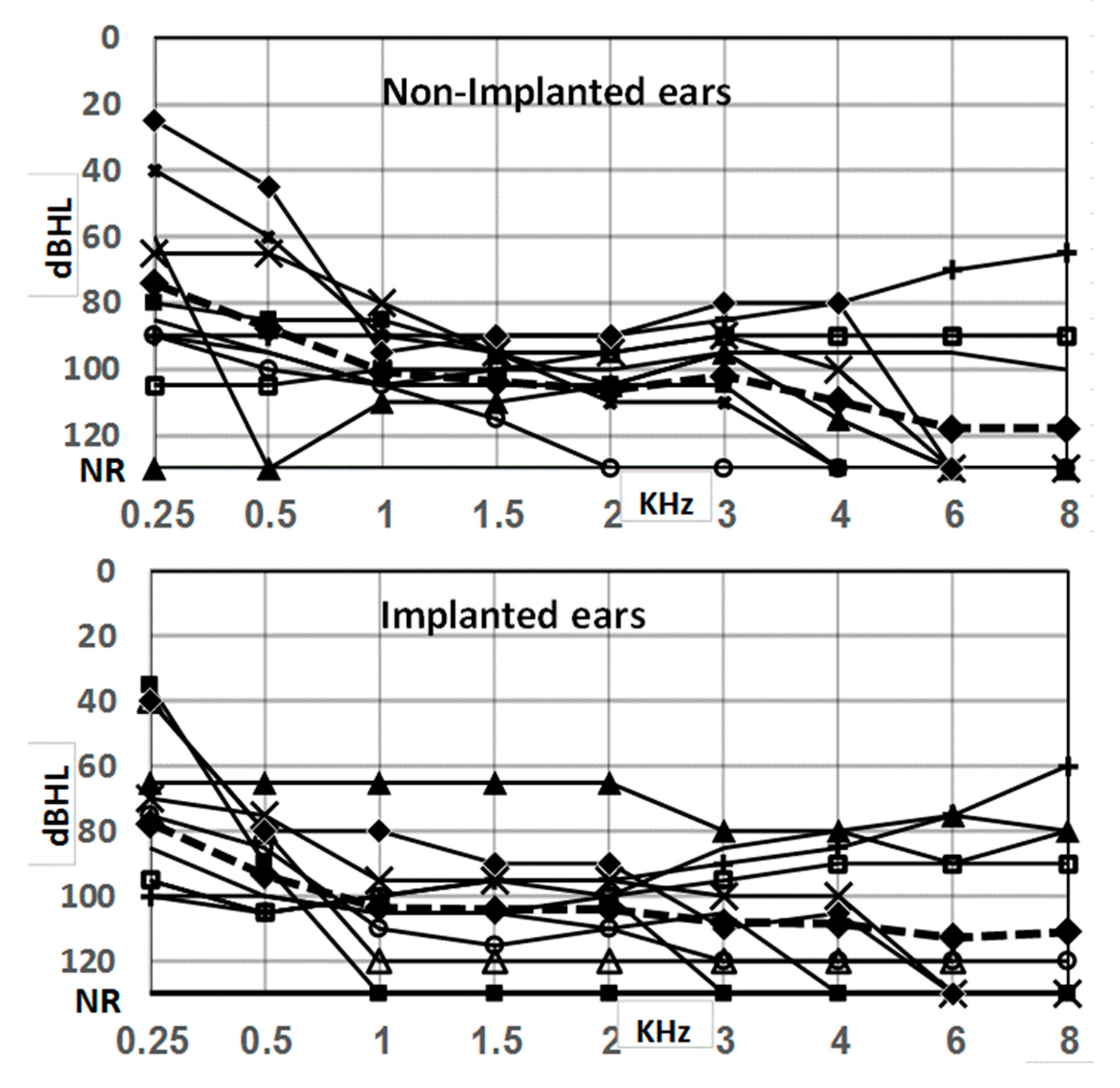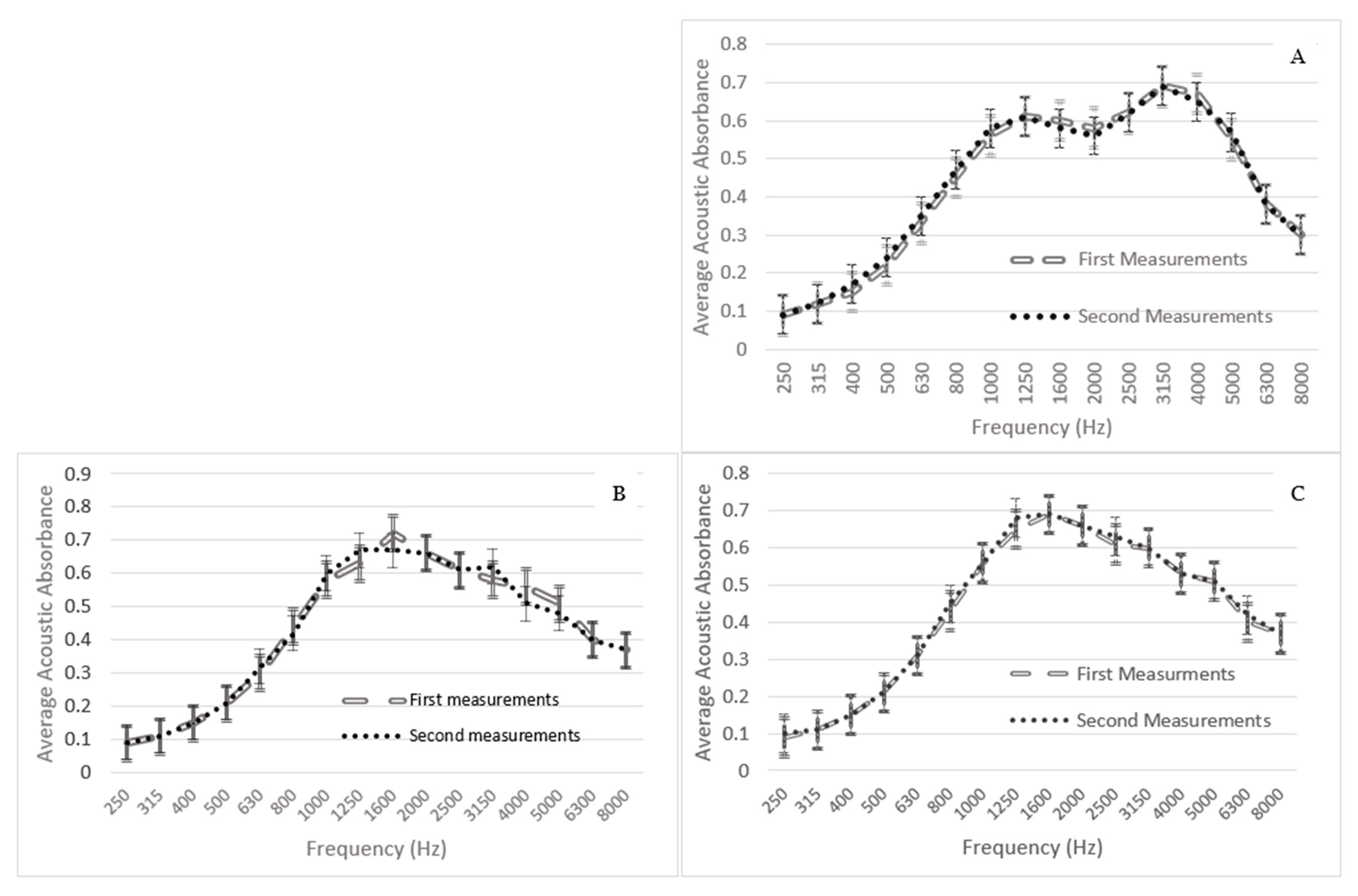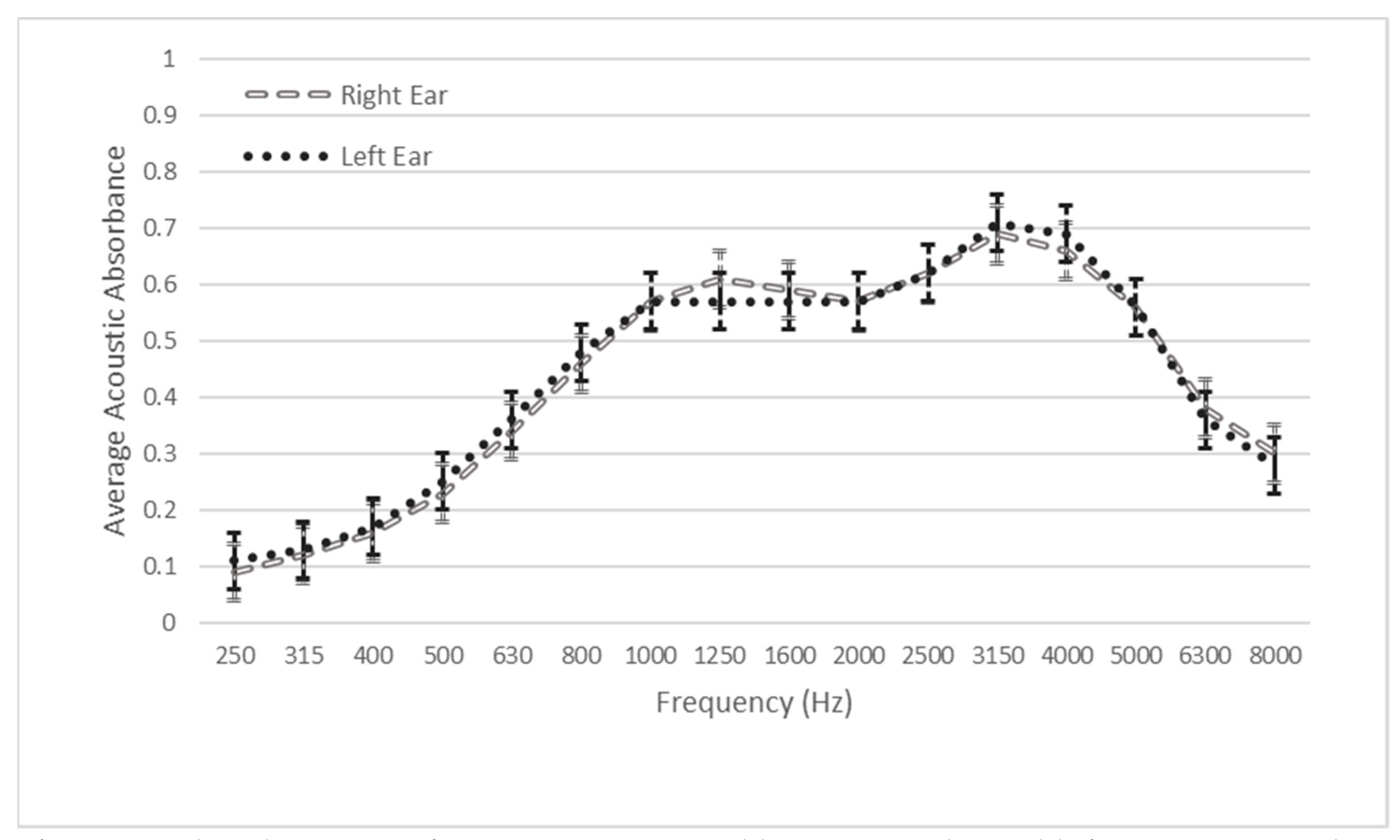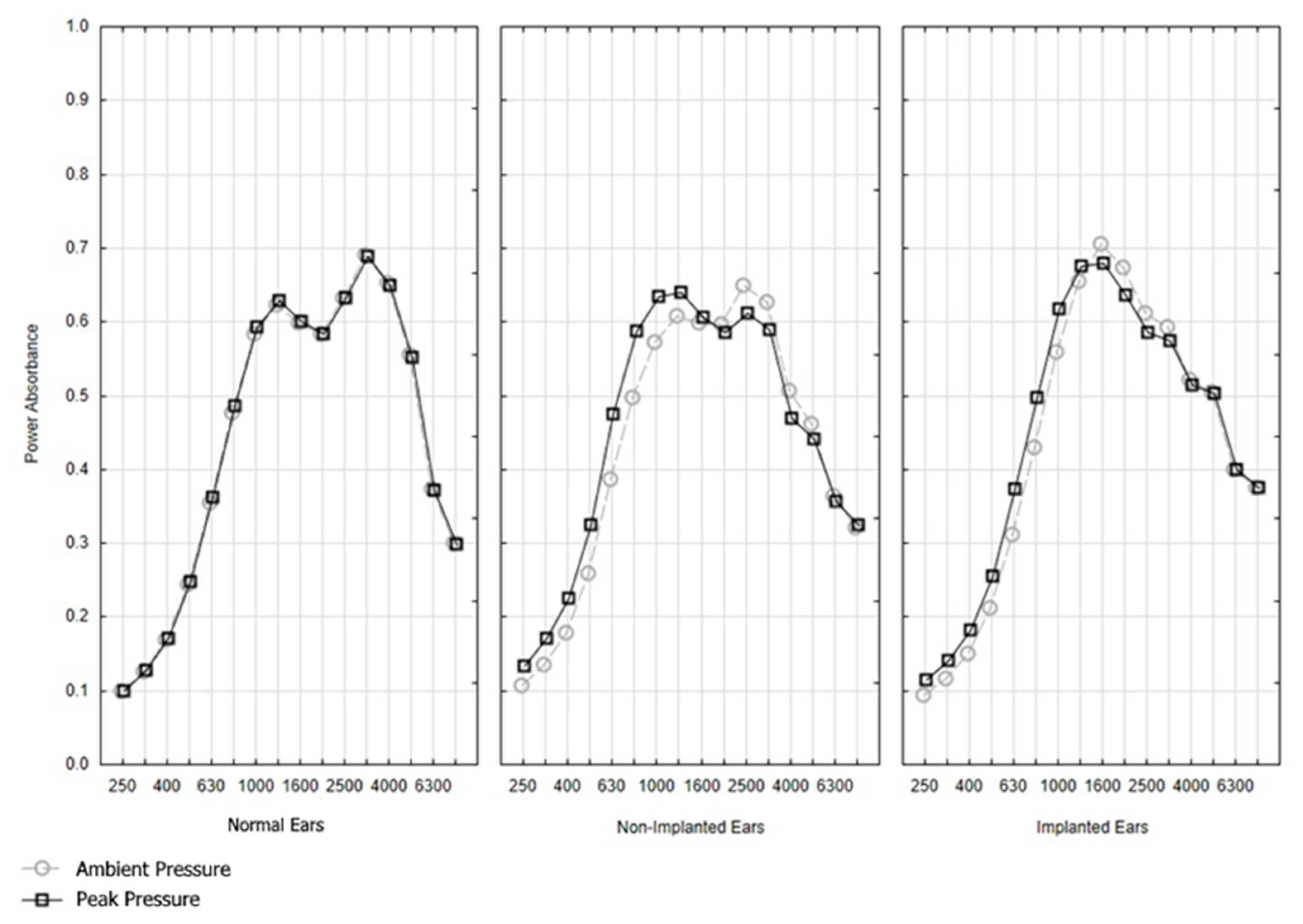Wideband Tympanometry in Adults with Severe to Profound Hearing Loss with and without Cochlear Implants
Abstract
:1. Introduction
2. Materials and Methods
3. Results
Test–Retest Reliability
4. Discussion
Author Contributions
Funding
Institutional Review Board Statement
Informed Consent Statement
Data Availability Statement
Acknowledgments
Conflicts of Interest
References
- Mikulec, A.A.; McKenna, M.J.; Ramsey, M.J.; Rosowski, J.J.; Herrmann, B.S.; Rauch, S.D.; Curtin, H.D.; Merchant, S.N. Superior semicircular canal dehiscence presenting as conductive hearing loss without vertigo. Otol. Neurotol. 2004, 25, 121–129. [Google Scholar] [CrossRef]
- Minor, L.B.; Carey, J.P.; Cremer, P.D.; Lustig, L.; Streubel, S.O. Dehiscence of bone overlying the superior canal as a cause of apparent conductive hearing loss. Otol. Neurotol. 2003, 24, 270–278. [Google Scholar] [CrossRef]
- Preis, M.; Attias, J.; Hadar, T.; Nageris, B.I. Cochlear third window in the scala vestibuli: An animal model. Otol. Neurotol. 2009, 30, 657–660. [Google Scholar] [CrossRef]
- Attias, J.; Preis, M.; Shemesh, R.; Hadar, T.; Negris, B.I. Animal Model of Cochlear Third Window in the Scala Vestibuli or Scala Tympani. Otol. Neurotol. 2010, 31, 985–990. [Google Scholar] [CrossRef] [PubMed]
- Attias, J.; Nageris, B.I.; Shemesh, R.; Shvero, J.; Preis, M. Superior canal dehiscence effect on hearing thresholds: Animal model. Otolaryngol. Head Neck Surg. 2011, 145, 648–653. [Google Scholar] [CrossRef] [PubMed]
- Merchant, S.N.; Nakajima, H.H.; Halpin, C.; Nadol Jr, J.B.; Lee, D.J.; Innis, W.P.; Rosowski, J.J. Clinical investigation and mechanism of air-bone gaps in large vestibular aqueduct syndrome. Ann. Otol. Rhinol. Laryngol. 2007, 116, 532–541. [Google Scholar] [CrossRef] [PubMed]
- Nakashima, T.; Ueda, H.; Furuhashi, A.; Sato, E.; Asahi, K.; Naganawa, S.; Beppu, R. Air–bone gap and resonant frequency in large vestibular aqueduct syndrome. Otol. Neurotol. 2000, 21, 671–674. [Google Scholar]
- Merchant, S.N.; Rosowski, J.J. Conductive hearing loss caused by third-window lesions of the inner ear. Otol. Neurotol. Off. Publ. Am. Otol. Soc. Am. Neurotol. Soc. Eur. Acad. Otol. Neurotol. 2008, 29, 282. [Google Scholar] [CrossRef]
- Nguyen, S.; Cloutier, F.; Philippon, D.; Côté, M.; Bussières, R.; Backous, D.D. Outcomes review of modern hearing preservation technique in cochlear implant. Auris Nasus Larynx 2016, 43, 485–488. [Google Scholar] [CrossRef]
- Gantz, B.J.; Turner, C.; Gfeller, K.E.; Lowder, M.W. Preservation of hearing in cochlear implant surgery: Advantages of combined electrical and acoustical speech processing. Laryngoscope 2005, 115, 796–802. [Google Scholar] [CrossRef]
- Huber, A.M.; Hoon, S.J.; Sharouz, B.; Daniel, B.; Albrecht, E. The influence of a cochlear implant electrode on the mechanical function of the inner ear. Otol. Neurotol. 2010, 31, 512–518. [Google Scholar] [CrossRef] [PubMed]
- Raveh, E.; Attias, J.; Nageris, B.I.; Kornreich, L.; Ulanovski, D. Pattern of hearing loss following cochlear implantation. Eur. Arch. Otorhinolaryngol. 2015, 272, 2261–2266. [Google Scholar] [CrossRef] [PubMed]
- Attias, J.; Hod, R.; Raveh, E.; Mizrachi, A.; Avraham, K.B.; Lenz, D.R.; Nageris, B.I. Hearing loss patterns after cochlear implantation via the round window in an animal model. Am. J. Otolaryngol. 2016, 37, 162–168. [Google Scholar] [CrossRef]
- Koka, K.; Saoji, A.A.; Attias, J.; Litvak, L.M. An Objective Estimation of Air-Bone-Gap in Cochlear Implant Recipients with Residual Hearing Using Electrocochleography. Front. Neurosci. 2017, 18, 11–210. [Google Scholar] [CrossRef]
- Santos, F.; Nadol, J.B. Temporal bone histopathology of furosemide ototoxicity. Laryngoscope Investig. Otolaryngol. 2017, 2, 204–207. [Google Scholar] [CrossRef] [PubMed]
- Linthicum, F.H., Jr.; Doherty, J.; Berliner, K.I. Idiopathic sudden sensorineural hearing loss: Vascular or viral? Otolaryngol.-Head Neck Surg. 2013, 149, 914–917. [Google Scholar] [CrossRef]
- Bommakanti, K.; Janani, S.; Iyer, J.S.; Stankovic, K.M. Cochlear Histopathology in Human Genetic Hearing Loss: State of the Science and Future Prospects. Hear. Res. 2019, 382, 107785. [Google Scholar] [CrossRef]
- Ishai, R.; Kamakura, T.; Nadol Jr, J.B. Abnormal tectorial membranes in sensorineural hearing loss: A human temporal bone study. Otol. Neurotol. 2019, 40, e732–e738. [Google Scholar] [CrossRef]
- Zhang, N.; Cai, J.; Xu, L.; Wang, H.; Liu, W. Cisplatin-induced stria vascularis damage is associated with inflammation and fibrosis. Neural Plast. 2020, 22, 8851525. [Google Scholar] [CrossRef]
- Kim, J.; Koo, M. Mass and stiffness impact on the middle ear and the cochlear partition. J. Audiol. Otol. 2015, 19, 1. [Google Scholar] [CrossRef]
- Dong, W.; Olson, E.S. In vivo impedance of the gerbil cochlear partition at auditory frequencies. Biophys. J. 2009, 97, 1233–1243. [Google Scholar] [CrossRef] [PubMed] [Green Version]
- Dewey, J.B.; Xia, A.; Müller, U.; Belyantseva, I.A.; Applegate, B.E.; Oghalai, J.S. Mammalian auditory hair cell bundle stiffness affects frequency tuning by increasing coupling along the length of the cochlea. Cell Rep. 2018, 23, 2915–2927. [Google Scholar] [CrossRef]
- Hunter, L.L.; Shahnaz, N. Acoustic Immittance Measures: Basics and Advanced Practice; Plural Publication: San Diego, CA, USA, 2014. [Google Scholar]
- Shahnaz, N.; Polka, L. Standard and multifrequency tympanometry in normal and otosclerotic ears. Ear Hear. 1997, 18, 326–341. [Google Scholar] [CrossRef] [PubMed]
- Keefe, D.H.; Sanford, C.A.; Ellison, J.C.; Fitzpatrick, D.F.; Gorga, M.P. Wideband Aural Acoustic Absorbance Predicts Conductive Hearing Loss in Children. Int. J. Audiol. 2012, 51, 880–891. [Google Scholar] [CrossRef] [PubMed]
- Margolis, R.H.; Hunter, L.L. Tympanometry-Basic Principles and Clinical Applications in Contemporary Perspectives on Hearing Assessment; Rintelmann, W.F., Musiek, F., Eds.; Allyn and Bacon: Boston, MA, USA, 1999. [Google Scholar]
- Shahnaz, N.; Feeney, M.P.; Schairer, K.S. Wideband acoustic immittance normative data: Ethnicity, gender, aging, and instrumentation. Ear Hear. 2013, 34 (Suppl. 1), 27s–35s. [Google Scholar] [CrossRef]
- Liu, Y.; Sanford, C.A.; Ellison, J.C.; Fitzpatrick, D.F.; Gorga, M.P.; Keefe, D.H. Wideband absorbance tympanometry using pressure sweeps: System development and results on adults with normal hearing. J. Acoust. Soc. Am. 2008, 124, 3708. [Google Scholar] [CrossRef]
- Merchant, G.R.; Roosli, C.; Niesten, M.F.; Hamade, M.A.; Lee, D.J.; McKinnon, M.L.; Ulku, C.H.; Rosowski, J.J.; Merchant, S.N.; Nakajima, H.H. Power Reflectance as a Screening Tool for the Diagnosis of Superior Semicircular Canal Dehiscence. Otol. Neurotol. 2015, 36, 172–177. [Google Scholar] [CrossRef]
- Zhang, L.; Wang, J.; Zhao, F.; Li, Y. Inner ear pressure evaluation using wideband tympanometry in children with Large Vestibular Aqueduct Syndrome LVAS): A pilot study. Int. J. Pediatr. Otorhinolaryngol. 2019, 128, 109690. [Google Scholar] [CrossRef]
- Kaya, S.; Cicek, C.B.; Ozbal, B.M. Wideband tympanometry findings in inner ear malformations. Auris Nasus Larynx 2019, 47, 220–226. [Google Scholar] [CrossRef]
- Shahnaz, N.; Bork, K. Wideband reflectance norms for Caucasian and Chinese young adults. Ear Hear. 2006, 27, 774–788. [Google Scholar] [CrossRef]
- Nørgaard, K.R.; Fernandez-Grande, E.; Laugesen, S. Incorporating evanescent modes and flow losses into reference impedances in acoustic Thévenin calibration. J. Acoust. Soc. Am. 2017, 142, 3013–3024. [Google Scholar] [CrossRef] [PubMed] [Green Version]
- Rosowski, J.J.; Nakajima, H.H.; Hamade, M.A.; Mahfoud, L.; Merchant, G.R.; Halpin, C.F.; Merchant, S.N. Ear-canal reflectance, umbo velocity, and tympanometry in normal-hearing adults. Ear Hear. 2012, 33, 19–34. [Google Scholar] [CrossRef] [PubMed]
- Feeney, M.P.; Kefee, D.H.; Hunter, L.L.; Fitzpatrick, D.F.; Garinis, A.C.; Putterman, D.B.; McMillan, G.P. Normative wideband reflectance, equivalent admittance at the tympanic membrane, and acoustic stapedius reflex threshold in adults. Ear Hear. 2017, 38, e142–e160. [Google Scholar] [CrossRef] [PubMed]
- Merchant, G.R.; Schulz, K.M.; Patterson, J.N.; Fitzpatrick, D.; Janky, K.L. Effect of Cochlear Implantation on Vestibular Evoked Myogenic Potentials and Wideband Acoustic Immittance. Ear Hear. 2020, 41, 1111–1124. [Google Scholar] [CrossRef] [PubMed]
- Saoji, A.A.; Shapiro, S.B.; Finley, C.C.; Koka, K.; Cassis, A.M. Changes in wideband tympanometry absorbance following cochlear implantation. Otol. Neurotol. 2020, 41, e680–e685. [Google Scholar] [CrossRef] [PubMed]
- Scheperle, R.A.; Hajicek, J.J. Wideband Acoustic Immittance in Cochlear Implant Recipients Reflectance and Stapedial Reflexes. Ear Hear. 2020, 41, 883–895. [Google Scholar] [CrossRef] [PubMed]
- Merchant, S.N.; Rosowski, J.J. Acoustics and mechanics of the middle ear. In Glasscock-Shambaugh Surgery of the Ear, 6th ed.; Gulya, A.J., Minor, L.B., Poe, D.S., Eds.; People′s Medical Publishing House: Shelton, CT, USA, 1998; pp. 49–72. [Google Scholar]
- Whittemore Jr, K.R.; Merchant, S.N.; Rosowski, J.J. Acoustic mechanisms: Canal wall-up versus canal wall-down mastoidectomy. Otolaryngol. Head Neck Surg. 1998, 118, 751–761. [Google Scholar] [CrossRef]
- Wasson, J.D.; Campbell, L.; Chambers, S.; Hampson, A.; Briggs, R.J.; O’Leary, S.J. Effect of cochlear implantation on middle ear function: A three-month prospective study. Laryngoscope 2017, 128, 1207–1212. [Google Scholar] [CrossRef]
- Feeney, M.P.; Grant, I.L.; Marryott, L.P. Wideband Energy Reflectance Measurements in Adults With Middle-Ear Disorders. J. Speech Lang. Hear. Res. 2003, 46, 901–911. [Google Scholar] [CrossRef]
- Shahnaz, N.; Bork, K.; Polka, L.; Longridge, N.; Bell, D.; Westerberg, B.D. Energy reflectance and tympanometry in normal and otosclerotic ears. Ear Hear. 2009, 30, 219–233. [Google Scholar] [CrossRef]
- Voss, S.E.; Merchant, G.R.; Horton, N.J. Effects of middle-ear disorders on power reflectance measured in cadaveric ear canals. Ear Hear. 2012, 33, 195–208. [Google Scholar] [CrossRef] [PubMed] [Green Version]
- Fayad, J.N.; Makarem, A.O.; Linthicum, F.H. Histopathologic assessment of fibrosis and new bone formation in implanted human temporal bones using 3D reconstruction. Otolaryngol. Head Neck Surg. 2009, 141, 247–252. [Google Scholar] [CrossRef] [PubMed]
- Choi, C.; Oghalai, J.S. Predicting the effect of post-implant cochlear fibrosis on residual hearing. Hear. Res. 2005, 205, 193–200. [Google Scholar] [CrossRef] [PubMed]
- Attias, J.; Rabinovics, N.; Nageris, B.; Hilly, O. The Impact of Superior Canal Dehiscence on Power Absorbance, Otoacoustic Emissions, and Hearing in Fat Sand Rats. Otol Neurotol. 2021, 42, 1104–1111. [Google Scholar] [CrossRef] [PubMed]
- Khetarpal, U.; Schuknecht, H.F.; Gacek, R.R.; Holmes, L.B. Autosomal dominant sensorineural hearing loss: Pedigrees, audiologic findings, and temporal bone findings in two kindreds. Arch. Otolaryngol.-Head Neck Surg. 1991, 117, 1032–1042. [Google Scholar] [CrossRef] [PubMed]
- Jacob, S.; Johansson, C.; Fridberger, A. Noise-induced alterations in cochlear mechanics, electromotility, and cochlear amplification. Pflügers Arch. -Eur. J. Physiol. 2013, 465, 907–917. [Google Scholar] [CrossRef]
- Canlon, B. The effect of acoustic trauma on the tectorial membrane, stereocilia, and hearing sensitivity: Possible mechanisms underlying damage, recovery, and protection. Scandinavian audiology. Supplementum 1998, 27, 1–45. [Google Scholar]
- Etholm, B.; Belal, A.J. Senile changes in the middle ear joints. Ann. Otol. Rhinol. Laryngol. 1974, 83, 49–54. [Google Scholar] [CrossRef]
- Gaihede, M.; Koefoed-Nielsen, B. Mechanics of the middle ear system: Age-related changes in viscoelastic properties. Audiol. Neuro-Otol. 2000, 5, 53–58. [Google Scholar] [CrossRef]
- Ruah, C.B.; Schachern, P.A.; Zelterman, D.; Paparella, M.M.; Yoon, T.H. Age related morphologic changes in the human tympanic membrane. A light and electron microscopic study. Arch. Otolaryngol.-Head Neck Surg. 1991, 117, 627–634. [Google Scholar] [CrossRef]
- Feeney, M.P.; Sanford, C.A. Age effects in the human middle-ear: Wideband acoustical measures. J. Acoust. Soc. Am. 2004, 116, 3546. [Google Scholar] [CrossRef] [PubMed]
- Mazlan, R.; Kei, J.; Ya, C.L.; Yusof, W.N.; Saim, L.; Zhao, F. Age and Gender Effects on Wideband Absorbance in Adults With Normal Outer and Middle Ear Function. J. Speech Lang. Hear. Res. JSLHR 2015, 58, 1377–1386. [Google Scholar] [CrossRef] [PubMed]
- Williams, M.M. Wideband Acoustic Immittance and DPOAE Changes in older Adults (Order No. 10113805). ProQuest Dissertations & Theses Global. (1802278545). 2016. Available online: https://www.proquest.com/dissertations-theses/wideband-acoustic-immittance-dpoae-changes-older/docview/1802278545/se-2?accountid=14656 (accessed on 30 May 2016).
- Feeney, M.P.; Keefe, D.H.; Hunter, L.L.; Fitzpatrick, D.F.; Putterman, D.B.; Garinis, A.C. Effects of Otosclerosis on Middle Ear Function Assessed With Wideband Absorbance and Absorbed Power. Ear Hear. 2020, 42, 547–557. [Google Scholar] [CrossRef] [PubMed]





| Participant Number | Age | Gender | Laterality | Cochlear Implant (CI) Electrode | Years from Implantation |
|---|---|---|---|---|---|
| 1 | 19 | M | R | ||
| L | 24CI | 17 | |||
| 2 | 85 | F | R | Contour Advance | 10 |
| L | |||||
| 3 | 50 | M | R | ||
| L | CI512 | 6 | |||
| 4 | 48 | M | R | CI512 | 1 |
| L | |||||
| 5 | 73 | M | R | ||
| L | CI532 | 1 | |||
| 6 | 60 | F | R | CI512 | 2 |
| L | |||||
| 7 | 71 | M | R | ||
| L | Contour Advance | 3 | |||
| 8 | 54 | F | R | ||
| L | CI532 | 1 | |||
| 9 | 74 | M | R | CI422 | 6 |
| L | Contour Advance | 6 | |||
| 10 | 53 | F | R | ||
| L | CI512 | 7 | |||
| 11 | 60 | F | R | CI532 | 1 |
| L | |||||
| 12 | 62 | M | R | CI532 | 1 |
| L | |||||
| 13 | 73 | M | R | Contour Advance | 4 |
| L | |||||
| 14 | 18 | F | R | Contour Advance | 11 |
| L | Contour Advance | 1 | |||
| 15 | 56 | F | R | Contour Advance | 2 |
| L | |||||
| 16 | 19 | F | R | Contour Advance | 13 |
| L | |||||
| 17 | 74 | M | R | CI532 | 1 |
| L |
| Implanted Ears with SNHL | Non-Implanted Ears with SNHL | ||||||||
|---|---|---|---|---|---|---|---|---|---|
| Ear # (Patient #) | ECV mL | TPP daPa | SC (mL) | Type | Ear # (Patient #) | ECV mL | TPP daPa | SC (mL) | Type |
| 1 (1) | 1.19 | −10 | 0.51 | A | 1 (1) | 0.85 | −12 | 0.44 | A |
| 2 (2) | 0.55 | −23 | 0.45 | A | 2 (2) | 0.72 | −2 | 0.49 | A |
| 3 (3) | 1.06 | −10 | 0.67 | A | 3 (3) | 1.02 | −4 | 0.98 | A |
| 4 (4) | 0.86 | −4 | 0.37 | A | 4 (4) | 1.25 | 6 | 0.87 | A |
| 5 (5) | 0.96 | −10 | 0.39 | A | 5 (5) | 0.96 | 2 | 0.4 | A |
| 6 (6) | 0.55 | −7 | 0.47 | A | 6 (6) | 0.52 | 0 | 0.68 | A |
| 7 (7) | 1.23 | 15 | 0.51 | A | 7 (7) | 0.93 | −6 | 0.54 | A |
| 8 (8) | 0.84 | −64 | 0.74 | C | 8 (8) | 0.66 | −97 | 0.95 | C |
| 9 (9) | 1.03 | −9 | 1.1 | A | 9 (10) | 0.89 | −43 | 0.77 | A |
| 10 (9) | 1.09 | −9 | 1.29 | A | 10 (11) | 0.76 | 8 | 0.61 | A |
| 11 (10) | 0.92 | −47 | 0.37 | A | 11 (12) | 0.93 | −45 | 0.64 | A |
| 12 (11) | 0.84 | 4 | 0.38 | A | 12 (13) | 1.32 | 10 | 1.26 | A |
| 13 (12) | 0.88 | −25 | 0.26 | A | 13 (15) | 1.28 | −13 | 0.87 | A |
| 14 (13) | 1.05 | −35 | 0.74 | A | 14 (16) | 0.6 | −4 | 0.39 | A |
| 15 (14) | 0.49 | 6 | 0.26 | A | 15 (17) | 1.37 | 2 | 0.39 | A |
| 16 (14) | 0.59 | −16 | 0.4 | A | |||||
| 17 (15) | 0.85 | 3 | 0.65 | A | |||||
| 18 (16) | 0.67 | 0 | 0.36 | A | |||||
| 19 (17) | 1.17 | 0 | 0.47 | A | |||||
| Frequency (Hz) | Implanted Ears | Non-Implanted Ears | F (1,28) | p-Value |
|---|---|---|---|---|
| 400 | 0.13 ± 0.04 | 0.18 ± 0.07 | 5.24 | 0.03 |
| 500 | 0.18 ± 0.06 | 0.26 ± 0.1 | 6.67 | 0.015 |
| 630 | 0.28 ± 0.08 | 0.4 ± 0.14 | 8.52 | 0.007 |
| 800 | 0.39 ± 0.1 | 0.51 ± 0.15 | 6.38 | 0.017 |
| 1600 | 0.69 ± 0.12 | 0.59 ± 0.12 | 5.64 | 0.025 |
| Frequency (Hz) | Implanted Ears | Normal-Hearing Ears * | F(1,73) | p-Value |
| 1600 | 0.69 ± 0.12 | 0.59 ± 0.11 | 4.85 | 0.003 |
| 4000 | 0.53 ± 0.2 | 0.66 ± 0.17 | 4.48 | 0.006 |
| Frequency (Hz) | Non-implanted Ears | Normal-Hearing Ears | F (1,69) | p-Value |
| 4000 | 0.50 ± 0.2 | 0.66 ± 0.17 | 4.42 | 0.006 |
| 5000 | 0.46 ± 0.16 | 0.56 ± 0.13 | 4.04 | 0.009 |
Publisher’s Note: MDPI stays neutral with regard to jurisdictional claims in published maps and institutional affiliations. |
© 2022 by the authors. Licensee MDPI, Basel, Switzerland. This article is an open access article distributed under the terms and conditions of the Creative Commons Attribution (CC BY) license (https://creativecommons.org/licenses/by/4.0/).
Share and Cite
Attias, J.; Shahnaz, N.; Efrat, C.; Westerberg, B.; Lea, J.; David, E.; Zavdy, O.; Hilly, O. Wideband Tympanometry in Adults with Severe to Profound Hearing Loss with and without Cochlear Implants. Appl. Sci. 2022, 12, 8879. https://doi.org/10.3390/app12178879
Attias J, Shahnaz N, Efrat C, Westerberg B, Lea J, David E, Zavdy O, Hilly O. Wideband Tympanometry in Adults with Severe to Profound Hearing Loss with and without Cochlear Implants. Applied Sciences. 2022; 12(17):8879. https://doi.org/10.3390/app12178879
Chicago/Turabian StyleAttias, Joseph, Navid Shahnaz, Chamutal Efrat, Brian Westerberg, Jane Lea, Eytan David, Ofir Zavdy, and Ohad Hilly. 2022. "Wideband Tympanometry in Adults with Severe to Profound Hearing Loss with and without Cochlear Implants" Applied Sciences 12, no. 17: 8879. https://doi.org/10.3390/app12178879
APA StyleAttias, J., Shahnaz, N., Efrat, C., Westerberg, B., Lea, J., David, E., Zavdy, O., & Hilly, O. (2022). Wideband Tympanometry in Adults with Severe to Profound Hearing Loss with and without Cochlear Implants. Applied Sciences, 12(17), 8879. https://doi.org/10.3390/app12178879







